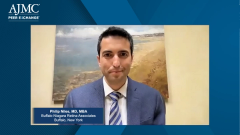
Emerging Therapies for the Treatment of Wet AMD and DME
Nicholas G. Anderson, MD, explores the use of a novel port delivery system with ranibizumab for the treatment of wet AMD.
Episodes in this series

Jim Kenney, RPh, MBA: Why don’t we move now to our next section to talk about emerging therapies and unmet needs and the future directions in the treatment of wet AMD [age-related macular degeneration] and DME [diabetic macular edema]. The first one I want to address is this novel port delivery system [PDS], which has recently become available with ranibizumab. Do you have experience with this PDS system, Dr. Anderson?
Nicholas G. Anderson, MD: We do. This treatment is brand new, relatively recent FDA approval. The drug component is still waiting on a permanent J-code for reimbursement, which has understandably limited the uptake with commercial payers. Although we certainly anticipate it down the road, but this is a typical rollout. It is a very new treatment, it hasn’t been implemented very widely yet, but our practice did participate in several of the clinical trials for the port delivery system. So we do have experience from the clinical trials and are just starting to get some real-world experience as well.
This is a product developed by Genentech [San Francisco, CA], recently approved by the FDA for wet macular degeneration. It’s marketed under the name Susvimo [ranibizumab]. It’s not yet FDA-approved for diabetic macular edema. It’s a very interesting device, in my opinion. It’s a really small device. It’s about the size of a grain of rice, maybe a little thicker than that, that we surgically implant into the wall of the eye in the operating room. That’s a key differentiator. Whereas all of the other anti-VEGF medications we administer by injection in the office, with the port delivery system, we do the initial implant in the operating room. After implanting the device in the wall of eye in the operating room, we go ahead and fill the device. It’s a hollow tube, and we fill it with essentially ranibizumab, just with a different concentration. We go ahead and do an initial fill in the operating room. And then that medication is very slowly released over approximately 6 months, although that interval could be even longer. Again, we do an initial surgery, and that patient theoretically will not need another injection in the office for about 6 months.
The clinical trials showed very similar visual outcomes between giving the patient monthly injections in the office with ranibizumab compared to an initial surgery and no treatment again for 6 months. After 6 months, as the reservoir is depleted of medication, we can refill that reservoir in the office. The process is somewhat similar to doing an intravitreal injection. It’s perhaps just a bit more complex, but not dramatically so. So at that 6-month interval, we will refill the device in the office, and then that patient hopefully will not need another intravitreal injection for 6 months.
It’s a brand new treatment, it’s very exciting. Again, that’s clinical trial data. We all know that real-world data rarely exactly mimic the FDA data. We’ll have to see if patients are going to need additional injections in between refills of the device, but that lower treatment burden could be important to patients. There was one safety concern in that the endophthalmitis rate of the surgical implant was significantly higher than intravitreal injection. Endophthalmitis is an infection on the inside of the eye. Compared to say pink eye, where you have a surface infection, this would be more akin to an abscess in the eye. Endophthalmitis can be an absolutely devastating infection. It requires rapid intervention and can result in permanent loss of vision. The endophthalmitis rate in the trial was relatively high. But I do think that that rate is going to come way down as surgeons gain familiarity with the implant technique. It’s a new device, it’s a new procedure. Understandably, the complication rates are going to be higher early, but I do expect that that complication rate will come down significantly.
I think it’s going to be really interesting though to see how this device is taken up. It is quite expensive on the front end. Theoretically, the costs should be fairly similar to monthly Lucentis [ranibizumab]. But we’re starting to see newer medications come to market that have a longer treatment interval. Again, as we saw with Beovu, for example, and we have faricimab coming down the pike, we’re seeing a lot of patients who respond very nicely to treat and extend. So if you have a patient who still requires monthly treatment for a very long time, I think that’s a great patient for this device. On the other hand, it may not be best for a patient who I’ve already extended out to perhaps 3 months, now you’re only doing 2 injections, 2 or 3, vs. going to the operating room, and potentially higher complications. I do think there’s going to be a role for this device and certainly, it’s not for every patient. It is just another great tool to have in our armamentarium.
Transcript Edited for Clarity
Newsletter
Stay ahead of policy, cost, and value—subscribe to AJMC for expert insights at the intersection of clinical care and health economics.






































